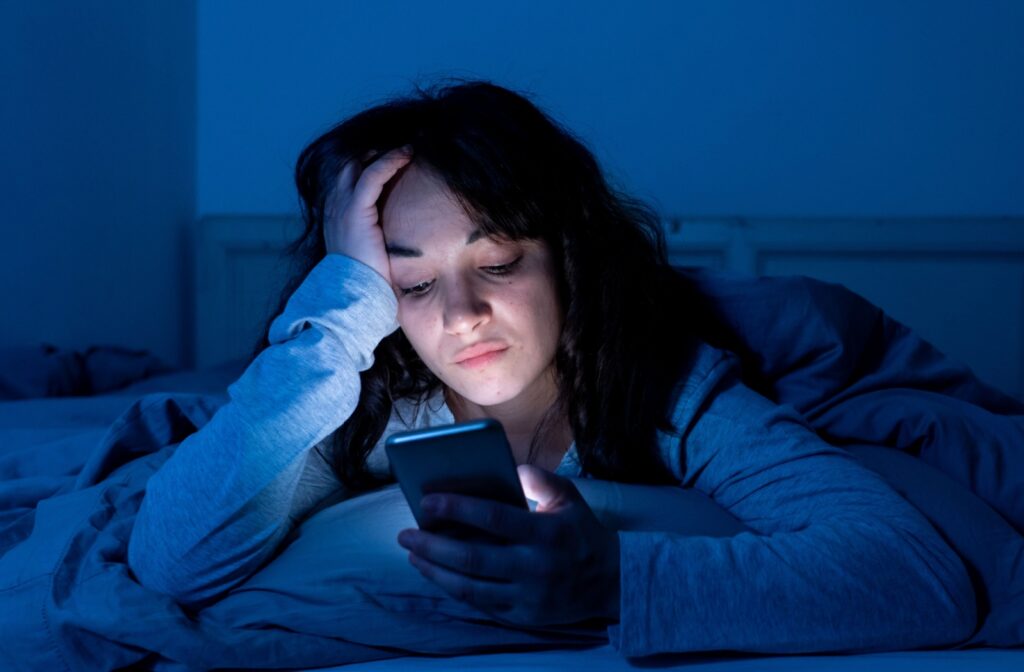In recent years, the use of LED lights has skyrocketed. LEDs appear everywhere, from our homes and offices to our smartphones and even streetlights. Praised for their energy efficiency and longevity, LED lights seem like a perfect solution for our lighting needs.
However, growing concerns about their impact on eye health have sparked an interest in understanding whether LED lights are truly safe for our vision. LED lights are generally safe for your eyes, but excessive exposure to blue light emitted by LEDs can affect your circadian rhythm, which affects your sleep patterns and may possibly contribute to eye strain. Excessive high-intensity exposure to blue light does carry possible long-term effects such as retinal damage.
At The Eye Avenue, we’re dedicated to your eye health and well-being. Our team of experienced professionals provides comprehensive eye care services, from routine eye exams to advanced treatments. With high quality technology and personalized care, we make sure that your vision is our top priority. Visit us today and see clearly with The Eye Avenue—where your eyes are in expert hands.
Understanding LED Lights
LEDs, or light-emitting diodes, efficiently convert electrical energy into light and come in various types, each suited for different applications. They feature different color temperatures and wavelengths, with brightness measured in lumens and efficacy in lumens per watt.
Unlike traditional incandescent bulbs, LEDs do not rely on heating a filament to produce light. Instead, they offer a more energy-efficient and environmentally friendly alternative with a longer lifespan.
The Concerns: Blue Light Exposure
One of the main concerns surrounding LED lights is their emission of blue light. Blue light is a segment of the visible light spectrum with wavelengths ranging from approximately 380 to 500 nanometers. It is characterized by its high energy and its shorter wavelengths compared to other colors of visible light.
Blue light is naturally emitted by the sun and is also produced by artificial sources such as LED lights, computer screens, smartphones, and other digital devices. While blue light during the daytime can boost attention, mood, and reaction times, excessive exposure, especially at night, can disrupt sleep patterns by suppressing the production of melatonin, a hormone that regulates sleep, and contributes to digital eye strain.

Blue Light & Digital Eye Strain
Digital eye strain, also known as computer vision syndrome, encompasses a range of eye and vision-related issues resulting from prolonged use of digital devices. Symptoms include dry eyes, blurred vision, headaches, and neck and shoulder pain. These symptoms arise because focusing on screens for extended periods can overwork the eye muscles, reduce blinking, and lead to poor posture.
Given that LED screens on computers, tablets, and smartphones emit significant amounts of blue light, it is reasonable to link them to the increasing frequency of digital eye strain. Blue light has been shown to scatter more easily than other visible light, making it harder for the eyes to focus. This can contribute to visual discomfort and fatigue.
Potential Long-Term Effects
Some studies suggest that continuous, high-intensity exposure to blue light may contribute to retinal damage over time. The retina, located at the back of the eye, is responsible for converting light into neural signals that our brain interprets as vision. Prolonged blue light exposure can potentially lead to conditions such as age-related macular degeneration (AMD). However, definitive evidence in this area is still ongoing, and more research is needed to establish a clear causal relationship.
Benefits of LED Lights
Despite the concerns, it’s essential to recognize the numerous advantages of LED lighting:
- Energy Efficiency: LEDs consume significantly less power than traditional incandescent bulbs, leading to cost savings and reduced environmental impact.
- Longevity: LED lights have a much longer lifespan, often lasting around 50,000 hours, reducing the frequency of replacements.
- Versatility: Available in various colors and intensities, LED lights can be adapted to a wide range of applications, from home lighting to outdoor displays.
- Eco-Friendly: LEDs contain no harmful substances (like mercury), making them safer for both the environment and human health.
Mitigating the Risks
To minimize the potential risks associated with LED light exposure, consider implementing the following strategies:
Follow the 20-20-20 Rule: Every 20 minutes, take a 20-second break and look at something 20 feet away to reduce digital eye strain.
Use Blue Light Filters: Many devices now come with built-in blue light filters or night mode settings that reduce blue light emission.
Maintain Proper Lighting: Make sure your workspace is well-lit to reduce glare and avoid straining your eyes.
Regular Eye Exams: Routine visits to an eye care professional can help monitor and maintain your eye health.
Balancing Benefits & Risks of LED Lighting
While concerns about LED lights and eye health are valid, they should be balanced against the numerous benefits offered by LEDs. By taking proactive measures to mitigate blue light exposure and practicing good eye care habits, you can enjoy the advantages of LED lighting without compromising your vision. As research continues to evolve, staying informed about the latest findings will help you make the best choices for your eye health and overall well-being.
At The Eye Avenue, we’re committed to helping you protect your vision. Incorporate our expert tips into your daily routine: adjust your device settings, follow the 20-20-20 rule, and schedule regular eye check exams. Stay informed with the latest research and make the best choices for your eye health. Start today—book your next eye exam with The Eye Avenue to safeguard your eyesight and continue to enjoy the benefits of LED lighting!




